Was VFXHQ your first foray into visual effects?
Pretty much. I had always been tinkering on my Mac with Photoshop and Premiere and After Effects, but as an avid reader of Cinefex and student of film (at the Northwestern University in Chicago) in general, I just wanted to train and learn how these illusions were made. There was really nothing out there other than Cinefex. It became my Bible. Cinefex was a fantastic resource, but I wanted to have something that was completely up to date. I just found myself researching the phone numbers and addresses of all the effects companies and getting on the newsgroups as much as I could. It was almost out of personal necessity. I had this personal database that I'd amassed and I thought, 'Well, maybe other people would like to read this and use this as a resource.' So I started putting it on my personal home page, eventually bought the domain name and things went from there. I just tried to make VFXHQ as honest and complete as possible so that not only professionals, but also fans would get something out of it.
Can you tell me about the mixture of explanations and articles?
There were subjective reviews too. Obviously, there's a lot of film criticism out there, but when it comes down to the technical and creative challenges of visual effects or editing or sound design or cinematography, there's very little subjective, informed criticism out there. The trade publications are pretty straightforward and they don't want to rock any boats. They want to be safe and keep the interviews coming.
I was more like, you know, if a certain shot really sucks, it's important that we talk about it. Not simply shout, 'It looks fake!'. I wanted to know from a film point of view why the shot failed. Was it something technical like the rendering method, the scale of the miniature, or was it something creative like the way it the shot was lit or composed, or how the shot played in the sequence? Or how it played within the whole movie? Did it take you out of the movie?
Those kinds of things you just don't read about frequently, but those are the discussions that filmmakers have when they're designing the effects. So, the idea was that the regular movie fan could walk out of the movie and go, 'Something really bugged me about that shot,' and if they were at all inclined they could just go to the website and learn a little bit about why it didn't work or why certain shots were fantastic.
The whole driving force behind the website was to talk about how visual effects support narrative film, how they work in suspending audiences' disbelief.
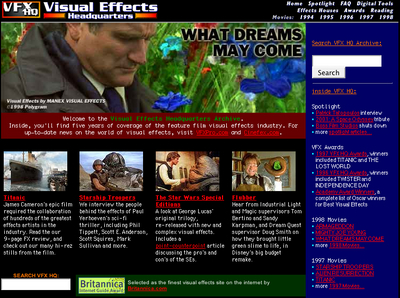
- Visual Effects Headquarters as it looks today.
What was your favourite article?
Probably the Starship Troopers coverage. Not only because the effects absolutely blew me away, but because that was in 1997 when I was getting more aggressive about doing interviews and speaking directly to sources. The 'How To' article I did where I got to interview Phil Tippett, Van Ling, Scott Anderson, VCE, Scott Squires from ILM and almost all of the major players on that film. That was just fantastic. I mean, getting Phil Tippett on the phone and getting his view on visual effects - that was definitely the high point for me as an effects fan.
It's funny because some of the people I interviewed way back then I ended up working with. Scott Anderson at for a short time on Hollow Man. Scott Squires. Van Ling gave me my first break in the industry. Jay Cooper's a fellow compositor at ILM. Every once in a while I chat with them and say, 'Remember the VFXHQ days?" I fully expect them to say, 'Yeah, you were a complete chump,' but they always are appreciative of the coverage that I gave them, and of the website in general.
At what point did you start moving into the industry?
It was basically late '97 when I was still working in Chicago and had been out of school for a couple of years. I was working on childrens' video games which was all very cool because I got to steer the video games in specific directions where I could use certain tools, like After Effects and Photoshop and Macromedia Director and getting the basics of compositing. There was just a point in 1997 where I said, 'You know what, I just gotta go for it. I have to try.' So I packed up my car and drove off to LA with no job prospects at all and not even a place to stay, just going after the opportunity to work in feature films.
Van Ling at Banned From The Ranch knew me through the website and knew that I was a Mac aficionado. He kind of knew where I was coming from as a student of film and gave me that first chance. He said, 'Hey, you wanna do some roto on Dr Dolittle,' and I was like, 'Absolutely!' By the end of Banned From The Ranch I was the lead artist there. Van gave me my first big break and I'll always be very grateful for that chance.
So could you do it? How difficult was it at first?
The great thing is that all of the years of my parents looking at me and going, 'Why are you rewinding that scene from Back to the Future and looking at it over and over? Why are you freeze framing through it? Why are watching Star Wars over and over again?', all of those things I learned observing and reading have come into fruition in my professional work. Film school certainly helped. Making films certainly helped. But it was the intense experimentation and observation of film techniques that I have absolutely used in my professional life.
With VFXHQ, I got a lot of letters from people wanting to get into the industry, asking what software they should learn and what schools should they enroll in. I always say the same thing: if you learn about film and filmmaking, what it means to tell a story, editing, photography, composition, sound - then the visual effects tools are the easy part. The hard part is understanding how to compose an image and how to tell a story that will affect people. There are lot of tech heads in our industry. They're geniuses in creating and writing those tools to help get the stuff to the screen, but the creative and artistic ability to be able to put together these images - that is what folks should be concerned with. I'm a pretty good example of that. I really don't like computers. I do not go to computer graphics conventions to learn about the latest, greatest chip sets and gigaflops or whatever. I just want to know what tools are there going to be to help me create these great images.
Access to the tools is getting better and better. When I was in college I was editing on VHS decks next to each other, and on a KEM, and it was great! Those kinds of tools were incredibly expensive and difficult to access at the time. Today you can buy a $500 Mac Mini that comes with iMovie and do your editing right then and there. After Effects is like, what, $700? You can be compositing your own stuff at home. You can burn your own DVDs. That is just amazing because 10 to 15 years ago you would have needed a post house to do all that stuff.
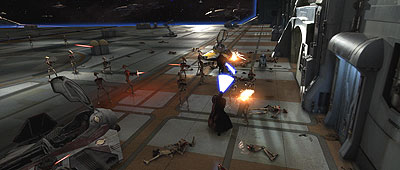
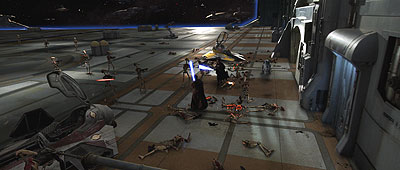
- Vaziri composited this shot of Obi-Wan and Anakin battling droids in the hangar of General Grievous' ship for Revenge of the Sith. Images copyright © 2005 Lucasfilm Ltd. All rights reserved.
Can you talk about your time after Banned From The Ranch at Flat Earth and then Pixel Magic?
Flat Earth was great because I got to work with Doug Beswick, Kevin Kutchaver and Kevin O'Neill. These guys had made significant contributions to visual effects. I mean, Doug had done stop motion on the AT-ATs for The Empire Strikes Back, one of the greatest sequences in visual effects history. It was so great working on Xena for Doug. I came in on the sixth season. In our season premiere, we had 270 effects shots in a single hour of television.
But the greatest thing about working on Xena at Flat Earth was that the producers of the show allowed us to experiment. They didn't give us any specific direction, not because of lack of knowledge or vision, but because they knew we could come up with things ourselves. That was a very freeing experience in terms of testing the limits about what we could do in the composite and with 3D animation. So it was really vibrant and exciting to be in charge of our own destiny. As long as it didn't distract from the story too much, they weren't going to have a problem with it. So Kevin and Kevin and Doug really let us loose just to make it big and interesting. The time frame was really much more fast paced than features so we had to pump out a lot of stuff quickly.
At Pixel Magic I came in and did some work on Little Nicky, Red Planet, and a lot of other movies. Then Driven was a big project for us. I was a compositing supervisor on that. We got to design the whole the sequence we worked on. We got to go wild. It was a very good, creative experience for me. Hart's War was a very similar thing. It was a little, tiny World War II movie that not a lot of people saw. It was a great opportunity to be at Pixel Magic. They've been around for a long time and have no signs of slowing down.

- A scene from Hulk. Image copyright © 2003 Universal. All rights reserved.
Can you tell me about some of your first projects at ILM?
On Star Wars Episode II I was on the Muren/Snow unit working on the factory sequence where Padme and Anakin get caught in that crazy droid factory on Geonosis, and also the clone war at the end. I still am amazed at how much quality we were able to pump out in such a short amount of time for those sequences. After that I helped out on Pirates of the Caribbean for a couple of weeks. Then Hulk was a fantastic experience, with Dennis Muren and compositing supervisor Marshall Krasser. So just being involved from the get go - from the first shot to the final shot was amazing. Van Helsing was another great experience, again with Ben Snow and Marshall as comp supervisor. I spent a lot of time on the prologue, the black and white scene that introduces the Frankenstein monster. I did the Universal logo burning up into the torch. Corporate logos are always great to destroy - I'll always volunteer for that. I also worked on a lot of the shots around the windmill and the destruction of the windmill.



What kind of software do you use at ILM?
We have an in-house compositing tool called CompTime. We've also been using a lot of Shake lately. I also use After Effects and Commotion in my own way. We also have our in-house 3D tool called Zeno. So on any given day I could be using five different compositing tools. I like to use whatever tool works for the job.
My favourite part of visual effects is compositing, because it involves bringing all the elements together. What is it that you like about compositing?
When I was making my own films the part that I got very excited about was creating the shots to go into the movie - creating the shots to be edited. I guess for visual effects the same paradigm is true for compositing. You get all these beautiful elements that have been shot, photographed on stage, created by the CG department, created by the matte painting department, blue screen and stock elements and you get to put them together. You get to make them look cool! That's really editing on a shot level.
When you're working on a show, is it difficult to view the final results?
Oh yeah. Just recently I tried to watch a little of Episode II and I was still too close to it. It was really hard to separate myself, especially on something like Star Wars or Van Helsing where basically you're working on the whole narrative. If you've worked on an effects sequence that's really isolated - that's one thing - you can still go into the movie and enjoy the characters from an objective standpoint. But when you're work is so highly integral to the narrative, it takes a long time to be able to stand back and say, 'Is this good enough? Did that work?', because you're looking at those images for weeks and weeks and weeks.




- The windmill sequence from Van Helsing. Images copyright © 2004 Universal. All rights reserved.
Can you tell me about your work on 'Episode III'? Let's start with the Mustafar shots.
The ones of Anakin and Obi-Wan traversing those pipes, overseeing the lava river, were some of the first shots to go through the facility so it was great to help set the tone with all the team working on those. It was a huge challenge to show the massive scale of the environment, without making it look like mush.
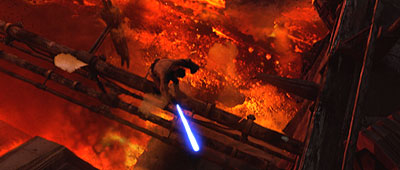
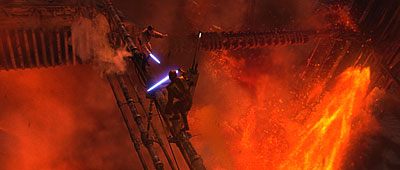
What elements made up the Mustafar shots?
This is one of the great things about working at ILM because pretty much every visual effects technique was used in those shots. We had the longest miniature shoot ever in ILM history with the Mustafar shoot which had the sculpted mountains that surround the lava fields. So we had a lot of miniature passes of that environment. On top of that we had computer graphic bloops, little tiny bloops to indicate it was boiling over just on the surface. Those were created by sequence supervisor Willi Geiger who was one the lead guys on CG lava. There were tons and tons and tons of real life smoke elements to help lend scale. For the pipe shot there was a billowing, dense black smoke that Aron Bonar, the TD on the shot, created, that was being created by the lava dam right behind them.
Then there was all of the CG pipes and facility, including the collection arm and the pipes themselves, the blue screen of Anakin and Obi-Wan doing their thing and real lava blasts photographed on a shoot by Ron Fricke of Mount Etna in Sicily when it was erupting. I mean, these elements were just so gorgeous. I think it was so cool that this was the first time ever in visual effects where we were simulating the volcanoes with actual volcano footage and being able to use them in places all over the movie and not just in wide shots. We used these blasts all over the movie and it really, really helped with the scale and in giving us the intensity of real life chaos.
So I put all those elements together with 3D compositing, along with heat distortion. Synthetic heat distortion bothers me a lot in movies because it never seems to work, so we worked really hard to try to make it feel good and hot. We also had blowing ash and embers in the frame so there's lots of bright glowy bits in the wind and also black sooty ash coming down. Kind of a little of everything! Managing that stuff was really a test, and then trying to make it not look like muck. All of the Mustafar stuff was supervised by my comp sequence supervisor, Mike Conte, and our overall comp supervisor Pat Tubach.
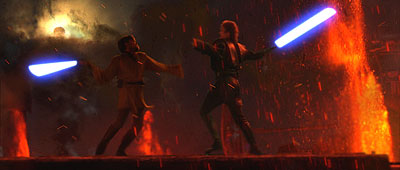


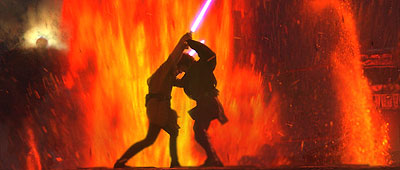
What was the most difficult thing about working on that sequence?
Probably trying to illustrate the chaos and the intensity of the situation. This was metaphorically hell. This is the worst, most dangerous part of the series, where these two friends are colliding and basically descend into darkness. So it was really difficult to sell the scale and intensity and immensity of the situation and the fierceness of the danger, whilst still trying to hone your eye into understanding the emotion of a real, human battle. With everything going on, we would have to balance all the chaos because we didn't want it to look like just a big mess. Sometimes clearing the frame if we had too much going on is what we did. Roger Guyett, the visual effects supervisor for the whole sequence, just nailed it. He knew exactly when to go over the top and when to pull back and stick with the characters, and keep the proper balance.
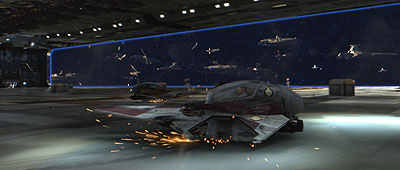
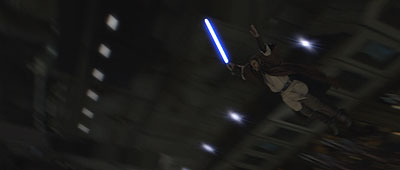
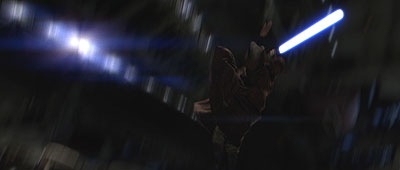
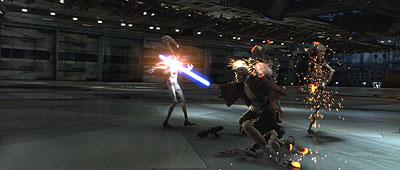
What can you tell me about the shot of Obi-Wan jumping out of his fighter in the hangar?
That was a fun one, one of John Knoll's shots. We're tracking with the skidding Jedi fighter, Obi jumps out, turns on his lightsaber and nails the droids. There was a lot going on in that shot. It was just a matter of making everything work and putting all the pieces together. The digital double work in that is so fantastic. The hair and the cloth and the animation is great work. That's one of the cool team effort type shots. The hangar itself is a photographed miniature, altered by our digital environments team. I got to do the fun stuff like sparks and lightsabers, all the stuff happening outside, the forcefields, flak bursts. It was just one of those entirely synthetic shots. Compositors have to spend a lot of time on those types of shots. We need to do everything we can to help sell the idea that this was captured in-camera, which is really difficult when the entire frame was created from scratch.
STAR WARS: EPISODE III - REVENGE OF THE SITH (c) 2005 Lucasfilm Ltd.
back to Professional
back to Star Wars: Episode III
